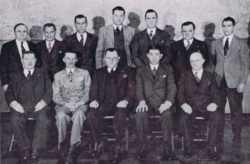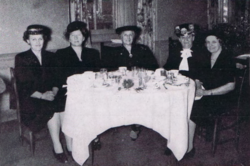Die deutsche Einwanderkolonie von Holyoke | |
|---|---|
  Members of the Holyoke Turn Verein in the Board of Directors and Ladies Auxiliary, 1946 | |
| Total population | |
| ≈2,660 (1895)[1][a] 1,887 (2017)[2] | |
| Languages | |
| American English, Upper Saxon German (in 19th century) |
| Part of a series on |
| Ethnic groups in Holyoke |
|---|
Despite representing a significantly smaller population than their Irish, French, Polish, or Puerto Rican counterparts, in the late 19th century through the mid-20th century, German immigrants predominantly from Saxony and Rhineland played a significant economic, cultural, and political role in the history of Holyoke, Massachusetts. The influx of these immigrants can largely be attributed to a single mill and millworker complex, the Germania Woolen Mills, which formed the basis of the immigrant colony (German: die deutsche Einwanderkolonie von Holyoke, lit. "the German immigrant colony from Holyoke") that would make the ward encompassing the South Holyoke neighborhood that with the highest German population per capita, in all of New England by 1875.[1] Along with unionization efforts by the Irish community, Germans would also play a key role in the city and region's socialist labor movements as workers organized for higher pay and improved living conditions in the textile and paper mill economies.[3]
Reflecting anti-German sentiment in the United States nationwide, as well as the concurrent decline of the Holyoke economy, much of the community dispersed or became Americanized following the World Wars in the 20th century; as of 2010, residents of German ancestry represented 4.7% or 1,887 of Holyoke's residents, and 6.0% or 27,526 residents in Hampden County.[2] With the exception of a handful of restaurants and institutions in the Greater Springfield area,[4] the influence of German culture in the city remains largely relegated to historical accounts today. Following this decline in the 1940s through 1970s, much of the Germania area of South Holyoke was razed or entirely redeveloped, with some exceptions such as the Turner Hall. Other institutions like the Sons of Hermann and Heinritz's Drug Store have been preserved and repurposed as a church and cultural center respectively, for the generation of Puerto Rican immigrants who began settling there in the mid-20th century.
- ^ a b Gerhard Wiesinger (2004). "Translating Gymnastics Into Economic and Political Power: The Rise and Decline of the German Turnverein in Holyoke, Massachusetts, 1871–1910". In Annette R. Hofmann (ed.). Turnen and Sport. New York, München, Berlin: Waxmann Münster. pp. 121–146.
- ^ a b "SELECTED SOCIAL CHARACTERISTICS IN THE UNITED STATES [ACS_10_5YR_DP02; for Holyoke city, Hampden County, Massachusetts]". US Census. Retrieved March 31, 2019.[permanent dead link]
- "SELECTED SOCIAL CHARACTERISTICS IN THE UNITED STATES [ACS_10_5YR_DP02; for Hampden County, Massachusetts]". US Census. Archived from the original on February 13, 2020. Retrieved March 31, 2019.
- ^ McCaffery, Robert Paul (1996). Islands of Deutschtum: German-Americans in Manchester, New Hampshire and Lawrence, Massachusetts, 1870-1942. P. Lang. OCLC 246910510.
- ^ O'Connell, James C (2017). Dining Out in Boston: A Culinary History. Hanover and London: University Press of New England. p. 113. ISBN 9781611689938.
Cite error: There are <ref group=lower-alpha> tags or {{efn}} templates on this page, but the references will not show without a {{reflist|group=lower-alpha}} template or {{notelist}} template (see the help page).
© MMXXIII Rich X Search. We shall prevail. All rights reserved. Rich X Search
